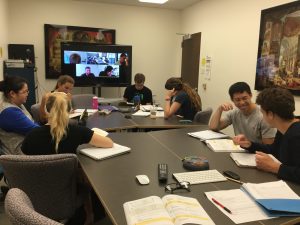
In 2015, I was hired as a lecturer in Swedish and Danish at UCLA. UCLA had long struggled with low enrollment in courses for less commonly taught languages and needed to find ways to reach more students. I was employed to open up the classroom at UCLA to all students within the University of California system. The goal was to have live lessons at UCLA with students on screens from all over California – blended synchronous classes. In building this, my team and I worked extensively with the Community of Inquiry framework. We placed a lot of emphasis on having a logical structure using a clear LMS (Canvas) (Cognitive Presence), regular lessons several times a week (Teacher Presence), and strategies to make all students feel part of the same group (Social Presence). We worked on the room layout so that the screen where distance students were located would be naturally placed around the table to include them in the classroom. We positioned the camera so that it was directed from the screen so that all students felt they had eye contact and were truly looking at each other. We worked a lot on sound and internet connectivity to ensure there would be no delay in conversation – all to create a completely natural environment for all students where everyone felt included on equal terms.
I have thought a lot about that time while working on topic 4. So much has happened and so much development has taken place since then. First, we had Covid, which forced everyone to learn how to use the tools we were trying to teach students to use in 2015, and suddenly it was not strange or difficult to have lessons via Zoom or Teams, and it was obvious for all teachers to use the university’s LMS in a logical and clear way (well, most of them at least). Then came AI and became a natural part of everyone’s life. If we had started the course redesign at UCLA now instead of in 2015, it feels like it would have been a walk in the park. So many obstacles are gone, and students and teachers are much more accustomed to working online and blended.
During the work on topic 4 in my PBL group, we have focused a lot on the integration of Gen AI into teaching and on how to balance its use, without losing focus on the Community of Inquiry framework. There are many factors that need to come together to create a good learning environment. From all I have read about the area and from the experience I have of using this in my own teaching, there is one thing that stands out as the most important one regarding this balance: Preserving humanistic teaching approaches and prioritizing human connections are essential for a balanced approach to AI integration in education.
References
Cleveland-Innes, M. & Wilton, D. (2018): http://oasis.col.org/bitstream/handle/11599/3095/2018_Cleveland-Innes-Wilton_Guide-to-Blended-Learning.pdf?sequence=1&isAllowed=y
Nufer, Sean (2003), blogpost: https://community.canvaslms.com/t5/Artificial-Intelligence-in/Balancing-Human-Touch-with-AI-in-Education/ba-p/590952